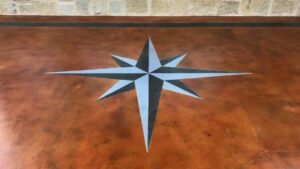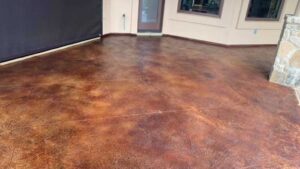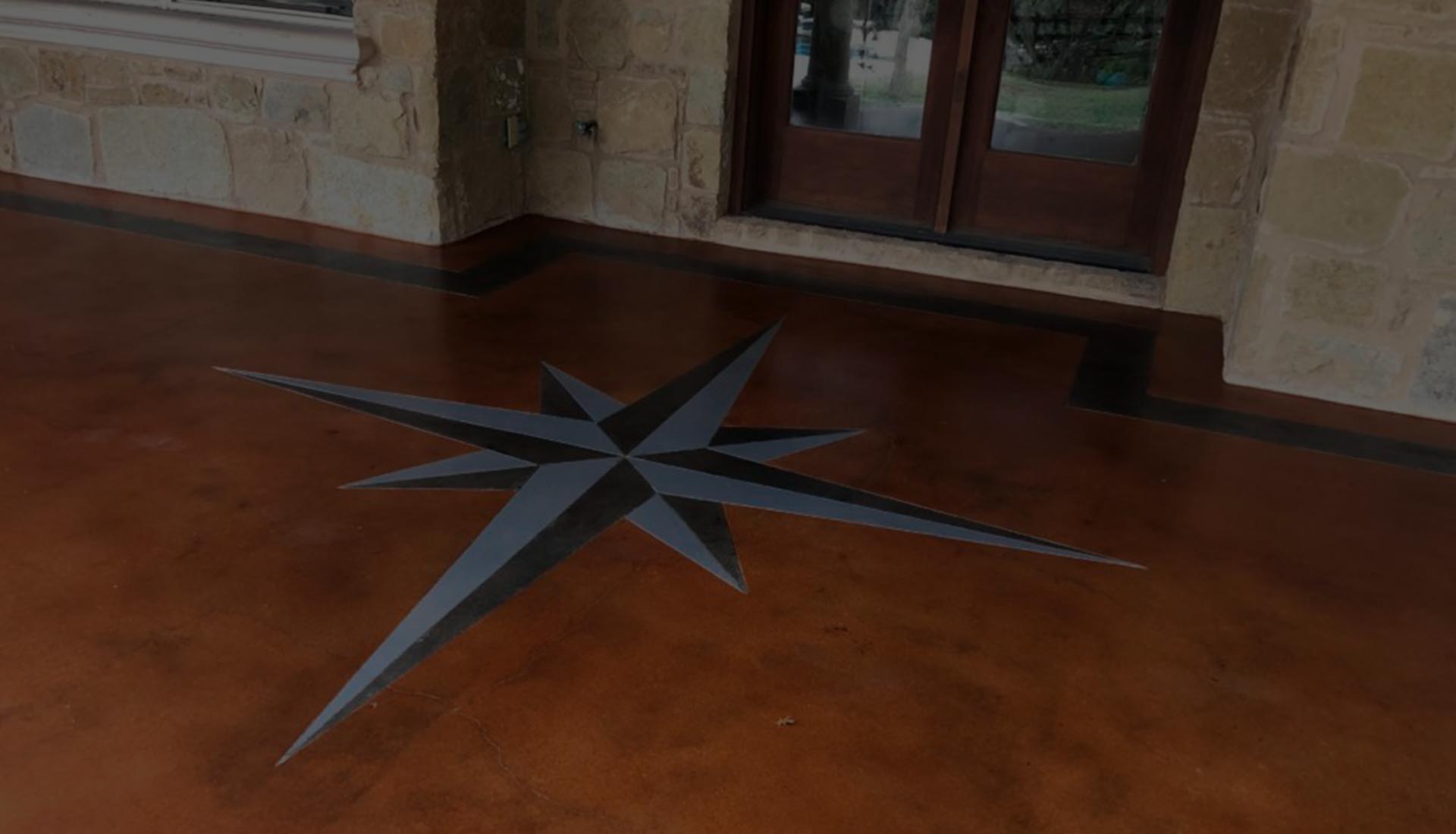Welcome to Suncoat of Texas, where our rich legacy in the construction and decorative concrete resurfacing industry spans over two decades. As a family-owned and operated business, we take pride in our commitment to honesty, integrity, and unparalleled craftsmanship. In this article, we delve into the world of stained concrete floors, a popular choice for both commercial and residential spaces.
We believe in empowering our clients with comprehensive knowledge, so we’ll explore the pros and cons of stained concrete flooring, ensuring that you are well informed to make the best decision for your space. Join us as we navigate through the aesthetic appeal, durability, and practical considerations of this versatile staining concrete flooring option.
A Brief Overview Into Staining Concrete Floors
Stained concrete floors are a distinctive and versatile option in modern architecture, renowned for their ability to combine aesthetic appeal with practicality. Stained concrete flooring involves applying stains to concrete surfaces to achieve a range of colors and effects, from rich, earthy tones to vibrant hues, often mimicking the appearance of natural stone, polished marble, or even wood. The popularity of residential stained concrete floors stems from its durability, cost-effectiveness, and low maintenance requirements.
Staining concrete floors are mainly of two types:
- Existing Concrete: This is the stained concrete floor you already have outside of your home, which can be made to look nicer with stains or polish.
- Decorative Overlay: This is a new layer of concrete, texture, and color sealer put over your old floor to hide damage or change its appearance.
However, considerations like its hardness, potential for coldness underfoot, and the complexity of installation and repairs are essential factors to weigh. Stained concrete floors for houses offer an eco-friendly flooring solution, appealing to those seeking a sustainable yet stylish interior design element.

A striking compass rose design inlays the stained concrete floor.
How to Choose the Stained Concrete Floor That Is Right for You?
Choosing stained concrete flooring for your house or commercial space is a decision that involves several key factors. Stained concrete offers a unique combination of durability, aesthetics, and versatility, making it an excellent choice for various settings. Selecting stained concrete flooring involves considering factors such as the purpose of the space, the type of stain, color, finish, and climate. That’s why it is crucial to understand the pros and cons of stained concrete flooring to make an informed decision.
The Pros of Stained Concrete Flooring
Aesthetic Flexibility
Stained concrete floors offer an incredible range of colors and finishes. This versatility means it can easily adapt to any style, from rustic to contemporary, making it an appealing choice for various design preferences.
Durability and Longevity
One of the most significant advantages of stained concrete floors is their durability. Properly installed and maintained stained concrete floors can last for decades, even in high-traffic areas. This longevity makes it a cost-effective solution in the long run.
Moisture and Stain Resistance
When sealed properly, stained concrete floors resist moisture penetration and staining, which is essential in a space where spills can be frequent.
Increases Property Value
Due to their durability, aesthetic appeal, and low maintenance, these stained concrete floors can increase the value of your property.
Low Maintenance
Ease of maintenance is another plus. Stained concrete floors require minimal upkeep – regular sweeping and occasional mopping are generally enough to keep them in top condition.
No Need for Waxing or Polishing
Unlike some flooring options, there’s no need to wax or polish stained concrete floors to maintain their shine and appearance. The sealant used during the staining process ensures a lasting finish that doesn’t require frequent touch-ups.
Durability Against Scratches and Scuffs
These staining concrete floors are highly resistant to scratches and scuffs, which is especially beneficial in spaces with heavy furniture or a lot of foot traffic.
Long Periods Between Resealing
The sealant on stained concrete floors can last several years, depending on the level of traffic and usage.
Cost-Effective
When compared to other flooring materials like hardwood or marble, staining and finishing concrete floors are often more budget-friendly, especially if the project involves an existing concrete slab that only needs staining and finishing.
Eco-Friendly Choice
For the environmentally conscious, stained concrete floors outside of the house are a sustainable option. It utilizes existing materials and reduces the need for new resources, aligning with eco-friendly building practices.
The Cons of Stained Concrete Flooring
Hard Surface
The hardness of concrete can be a downside. A stained concrete floor might be uncomfortable to stand on for extended periods and pose a risk of slips and falls. Moreover, objects dropped on concrete are more likely to break.
Acoustics
Staining concrete floors can contribute to a noisier environment as they do not absorb sound like softer flooring materials. This can be a consideration in spaces where echo and noise levels are a concern.
Potential for Cracks
Despite their durability, residential staining concrete floors can develop cracks over time due to settling or shifts in the foundation. While these are often minor and can add to the aesthetic, they may require repair if they become significant.
Health Considerations
For those with joint issues, such as arthritis, the hard surface of concrete can exacerbate discomfort. It’s important to consider this when choosing stained concrete flooring for houses where individuals with such conditions reside.
Temperature Sensitivity
Residential stained concrete floors can feel cold, particularly in lower-level spaces or during colder months. While this can be mitigated with rugs or heating systems, it’s an added factor to consider.
Installation Expertise
Achieving the perfect staining and finishing on concrete floors is not a straightforward task. It requires professional expertise and precision, factors that Suncoat at Texas prides itself on providing.
Limited Changeability
Once stained, altering the appearance of staining concrete floors is not a simple endeavor. It generally involves significant effort, whether it’s re-staining or covering it with another flooring material.
Planning for Long-Term Design
Given these challenges, it’s important for homeowners to carefully consider their long-term design preferences and needs before opting for stained concrete flooring. Choosing a timeless and versatile color and design can help mitigate the need for changes in the future.
Complexity in Re-Staining
While it’s possible to re-stain concrete floors, the process is complex and labor-intensive. It often requires stripping the old stain, preparing the surface again, and reapplying a new stain. This can be a time-consuming and costly endeavor.
Average Cost of Staining Concrete Floors
The cost of staining concrete floors can vary depending on several factors, and the desired finish and the contractor’s expertise play a significant role in determining the final expense.
Here is a short list of factors that can influence the average cost of staining concrete floors:
- Size of the Area: Larger areas typically cost more due to the increased amount of materials and labor required.
- Complexity of the Project: Complex designs and patterns of residential stained concrete floors can increase the cost.
- Type of Stain Chosen: Different types of stains can have varying prices.
- Location: The stained concrete floor cost may vary depending on the geographical location and local market rates.
- Desired Finish: Specific finishes, like glossy or matte, can affect the overall cost of stained concrete floors.
- Contractor’s Expertise: Experienced contractors may charge more for their expertise and high-quality work.
- Condition of the Concrete: Costs can rise due to the preparation required before staining the concrete floors.
- Accessibility: Difficulty in accessing the area to be stained can add to the labor costs.
- Timeframe: A faster completion time may require additional resources and thus increase the cost.
- Additional Features: Incorporating borders, custom graphics, or multiple colors can also add to the expense of concrete floor staining.
To obtain an accurate estimate for your specific project, it is advisable to consult with experienced contractors who can assess your requirements and provide a customized quote for stained concrete floors.

An inviting patio area with a concrete floor stained in natural hues.
Why You Should Hire A Contractor for Staining Concrete Floors?
When you choose Suncoat at Texas, you’re not just selecting a service; you’re embracing a partnership with a team passionate about decorative stained concrete floors. We are dedicated to transforming your existing pool decks and other outdoor concrete surfaces into luxurious, durable, and beautiful stained concrete floors that reflect the quality and elegance of your home.
We are serving the following areas:
- Austin
- Georgetown
- Round Rock
Contact us and let us bring our expertise and passion to your next project and experience the Suncoat difference.
Stained Concrete Flooring – Your Questions Answered
1: Can you stain an existing concrete floor?
Yes, you can stain an existing concrete floor. Staining can be applied to both new and old surfaces, making it a versatile option for renovation projects. Proper preparing concrete floors for staining is essential to ensure a long-lasting finish.
2: Can stained concrete flooring be used in high-traffic areas?
Stained concrete flooring is known for its durability and can withstand high-traffic areas, making it an excellent choice for both residential and commercial spaces. Regular maintenance and sealing can help preserve its appearance and performance.
3: Can stained concrete flooring be repaired if it cracks or chips?
Depending on the extent of the damage, repairs of stained concrete floors can range from simple patching to more extensive solutions for significant damage. It’s advisable to consult with a contractor to address any damage effectively.

